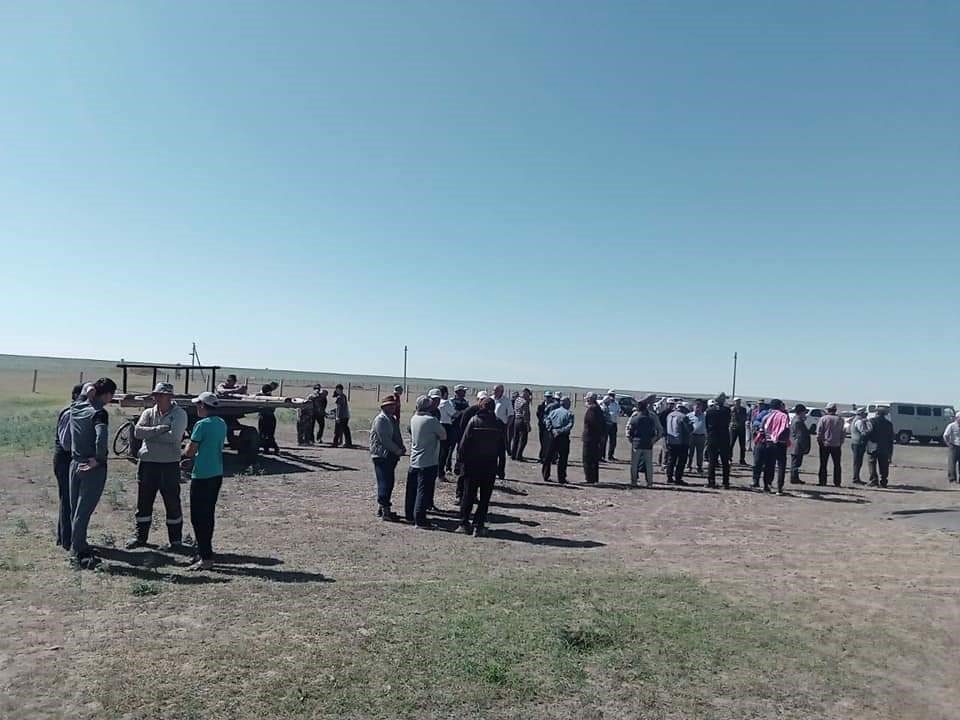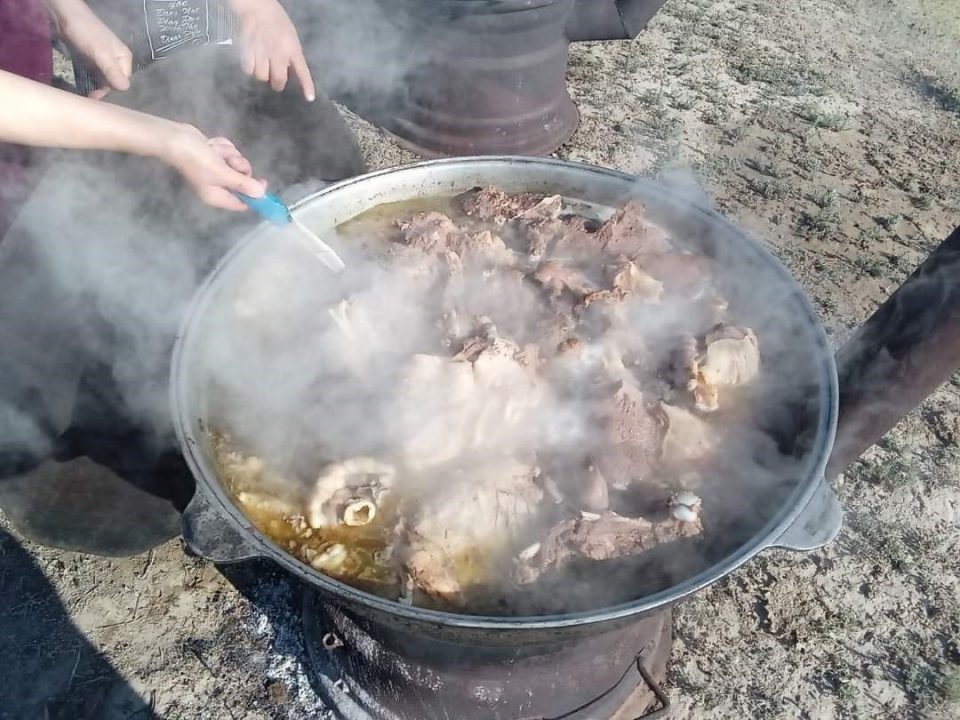Central Asian states have experienced a record abnormal heat wave as thermometers hit record-high temperatures. According to experts, such weather becomes a new normal in the region.
Tajikistan
Tajikistan faces abnormal heat for the first time in almost 80 years. According to a Tajik ecologist, such increase in temperature will become more intensive and lasting because of the global change.
In early July 2022, Tajikistan had average temperature varying from +33 to +43 degrees Celsius. The average temperature in the country during the month, according to meteorological forecasts, can be +37 degrees. In July 2021, this indicator was +27.7 degrees, and in July 2020, +25.4 degrees.

According to the Hydrometeorology Agency of Tajikistan, the country has abnormal rise in air temperature in July up to 45-47 degrees Celsius, which can have a negative impact on people’s health. According to the Agency, the last time thermometers reached +47 degrees was 78 years ago, in 1944, in the village of Aivadzh, now Shakhritus district of Khatlon region.
Maruf, a seller at one of Dushanbe-based greengrocery, complains about fatigue, dizziness, and small appetite because of hot weather.
“Despite the air conditioner at my workplace, I take a break and my son replaces me when it gets very hot,” he said.
The heat keeps him from work as he has heart problems.
“Sometimes after work, I have a haze over my eyes and I have no appetite. I often see my doctor as I have a chronic disease. I take medicines and try to work less, but I still have to work,” Maruf said.
Tajikistan has a harsh continental climate, and temperatures in the valleys and uplands vary significantly because of the mountain terrain. The average July temperature for the valleys in the southwest of the republic is nearly 30 degrees.
Kazakhstan
In Kazakhstan, abnormal heat also hits record-high temperatures in 30 years, +45.5 degrees was reported in the west of the country, according to Kazgidromet. Most of July, the western part of the country, as well as southern regions were under the influence of subtropical air masses, which caused the abnormal heat. The weather alert was announced in 11 regions of Kazakhstan.
Because of high temperatures, some cities have poplar fluff burning, with fire-fighting crews responding to dozens of calls. The country has forests and fields burning. Three mountain fires were suppressed in Almaty for just one day.
In Turkestan district, the heat caused the heave of the cement concrete pavement along the route Samara-Shymkent and the portion of the road “Western Europe-Western China” heaved.
In some regions of the country, people perform the ritual “tasattyk”, a prayer asking for some rain by offering sacrifice.
Residents of Zharkol village, Kostanai region. Photo: CABAR.asia
Bus driver of Kyzylorda Sabit Muratbekov said it was impossible to get outside in the last 10 days.

“We are advised to stay home. But we have no other way out, we have to work and earn daily bread. I work as a bus driver and no one gives us a day off. It’s a shame that air conditioners in buses and cars do not function. I’d like to have the formal order because no one will reduce working hours or give a day off without a document,” he said.
Over 200 people per month call an ambulance because of hot weather, said Vyacheslav Dudnik, Vice Minister of health of Kazakhstan, at the brief on July 27. 211 people sought emergency treatment with the diagnosis “high temperature effects” in July. In June, the number was 234.
“I was walking under the sun all day, got sunstroke, and was hospitalised. I had sudden hallucinations, cramps. Body temperature was as high as 42. Doctors told me I would be staying 10 days in the hospital. I didn’t know that blood stroke can happen because of overheat,” Assem Nurlanova, student of Almaty, said.

Animals have hard times, too. The Almaty zoo provides cooling water for animals.
“We have installed pools for bears, bought special sprinklers. We give bananas and ice to monkeys. It’s hard to look at them. Some animals became sick and we do all we can,” Rimma Narbaeva, worker of the Almaty zoo, said.
According to Kazgidromet, five regions of the country will have droughts in August – Mangistau, Kyzylorda, Kustanai, Karaganda and Aktyubinsk. Moreover, the abnormal heat can lead to active glacier melting near Almaty. Proglacial lakes (formed as a result of glacier movement and melting – editor’s note) in the mountains of Almaty have a potential risk for the megalopolis,” specialists of Kazselezashita said.
“We are now actively working. If the temperature keeps that high, there’s a great threat. This season, we have the automated system of glacial lake monitoring working in full. It has 31 stations located high in the mountains. They monitor the temperature of water, air, precipitation rate, soil dampness. Cameras function in real time mode,” said Nursultan Aldongar, acting chief of the emergency prevention office of the Emergency Department of Almaty.
Kyrgyzstan
From July 20, Kyrgyzstan, particularly Bishkek, had temperatures up to +40 degrees Celsius in the shade. However, according to Kyrgyzgidromet, this figure is not a record. The absolute maximum temperature in the capital was in July 1983. Back then, the air temperature was as high as +42.8 degrees. It was the highest figure in the history of observations.

Despite the current hot weather, representatives of state bodies say that the situation is under control, and life of citizens is normal. According to Egor Borisov, deputy director of the Emergency Medicine Centre, the number of citizens’ requests did not increase because of hot weather.
“Every day, 40 ambulance cars work in the city. Medical workers work as usual. Fortunately, no lethal cases caused by hot weather have been reported,” Borisov said.
Talking about the cases of faints in Bishkek, Borisov said that it is difficult to differentiate the causes of faints. According to him, this is a frequent phenomenon, yet it can be caused by anything.
“It can be caused by chronic diseases, neurological disorders, and hunger,” the expert said. “Therefore, it cannot be associated with hot weather.”
Nevertheless, high temperatures make it uncomfortable to stay outdoors. The ministry of interior affairs decided to use water cannons that used to be used to disperse protesters to cool down pavement temperatures and water trees in Bishkek.
Посмотреть эту публикацию в Instagram
The republican ministry of agriculture reported about relatively stable situation. Last year, croplands in the north of the country, especially in Chui region, faced an unprecedented draught and lack of irrigation water. Farmers took out to numerous protests and demanded from the authorities to take measures to preserve crops. According to Abdybai Dzhailoobaev, deputy director of the Water Resource Service, there are no such problems this season. As well, as there is no draught.
“For example, the volume of water in Orto-Tokoi reservoir this time last year was 53 million cubic metres, and now it is 133 million. Last year, the Kirov reservoir had 102 million cubic metres of water, and now 270 million,” Dzhailoobaev said to CABAR.asia.
According to the expert, these results could be achieved because the preparatory works for the irrigation season were financed in full. Channels and irrigation networks were repaired on time.
The emergency ministry of Kyrgyzstan also reported that hot weather did not cause fires or other similar accidents. According to Askat Mukanov, senior officer of Fire-fighting and fire prevention office, 79 fires happened in the country in July 15 to 22, 2022. Last year, there were 62 fires in the same period.
“In other words, there were more fires in this period, but they have nothing to do with hot weather,” Mukanov said. “Incidents often took place because of the human factor.”
Uzbekistan
The peak of hot weather in Uzbekistan was on July 17-20. The daytime temperature reached as high as 45 degrees Celsius, and in the south of the country and in desert areas it reached 47 degrees. Hundreds of thousands visits to hospitals were reported these days, over four thousand people were hospitalised.
Now the temperature in Tashkent reaches as high as 40-43 degrees, and up to 45 in the south of the country. According to the Ministry of Energy, power lines overheat because of hot weather. Moreover, electricity consumption increased. According to the agency, in summer 2021, the average daily indicator of electricity consumption as of July 22, 2022 was 237 million kWh, which is 6 per cent more than that last year.
Overheating and overloading can cause breakdowns, therefore the Ministry of Energy from time to time cuts power to lessen the load on power lines.
It will be even worse
Abnormally high temperatures in Central Asian states were reported last year, as well. Experts warned that the average temperature in the region will increase every year.
“The phrase “abnormal heat” is usually used when air temperatures are close to record values and exceed average maximum values,” said Timur Idrisov, senior adviser to ecological organisation “Little Earth”.
But, according to him, it is not the case of abnormal summer heat.
“Because of climate changes taking place, strong heat waves will emit more often, become more intense and will last longer,” Idrisov said.
Zoya Kretova, climatologist, said that the consequences of the global climate change have impact on the duration of summer and number of hot days.
“The number of days with high temperatures increases. We often face heat waves, when abnormally high temperatures last for several days in a row. Duration of such waves becomes longer and the number of cases increases, too,” she said.
Central Asia is one of the most vulnerable to climate change regions in the world, said Roman Vakulchuk, researcher of climate change and green energy at the Norwegian Institute of International Affairs, to CABAR.asia. The average annual temperature rises more rapidly than in the world, and the region resembles more the Middle East countries such as Kuwait or Saudi Arabia by its climate and perception.
“We can acknowledge that this temperature will become a norm. More important questions to consider are whether the temperature will increase more and at which pace. In general, the forecast is unfavourable if we keep to the pessimistic scenario,” he said.
See the full interview with Roman Vakulchuk here.
Medical workers alert
When high ambient temperature affect the human body, it tries to improve heat loss in order to preserve its own heat balance, according to general practitioner based in Dushanbe Oksana Goncharova. It happens due to hyperhidrosis. Also, prolonged exposure to heat increases body temperature, increases pulse rate, decreases gastrointestinal activity (GI), worsens normal function of the cardiovascular system (CVS).
High temperatures causes vascular distention, thus increasing pressure, which leads to heart overload.
“Therefore, people with excessive weight or diabetes mellitus have the increased risk of thrombus formation, atherosclerosis and other complications,” Goncharova said.
If the thermal control system fails to manage the thermal load, the body gets overheated and some complications can occur such as heat stroke, heat faint, cramps, water-related disease, neural disorders, heat exhaustion.
Cardiologist Mekhrob Davlatov recommends to stay away from heavy loads in hot weather and avoid huge temperature swings.
“Once summer comes, people tend to go hiking more often. But I think people need to avoid increased physical load, which increases the normal temperature of the body. It can lead to the excessive work of the cardiovascular system and acute chronic condition,” the specialist said.
According to dermatologist Dilnoza Baeva, pyodermatitis, various dermatitis, eczema recurrence and cutaneous mycoses often increase in hot weather.
“High ultraviolet doses for skin can cause burns and contribute to formation of melatonin that aggravates some pigment disorders related to skin colour change. The increased exposure to ultraviolet plays an important role in skin cancer development,” Baeva said.




